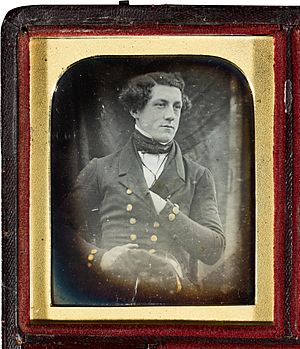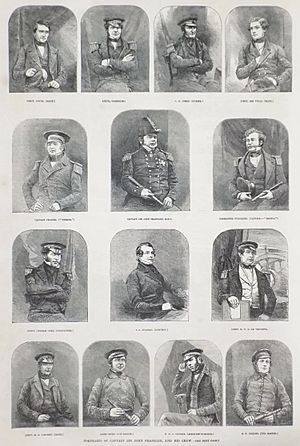Charles Frederick Des Voeux facts for kids
Quick facts for kids
Charles Frederick Des Voeux
|
|
|---|---|
 |
|
| Occupation | Naval officer |
| Rank | lieutenant (1846–) |
| Branch | Royal Navy |
Charles Frederick Des Voeux (born around 1825—died after May 28, 1847) was an Irish officer in the British Royal Navy. He was a mate aboard HMS Erebus. This ship was part of the 1845 Franklin Expedition.
The expedition aimed to map the Canadian Arctic and find the Northwest Passage. It also planned to make scientific observations. Sadly, all members of the expedition, including Des Voeux, died. Their exact fate in what is now Nunavut, Canada is still a mystery. Des Voeux and Graham Gore signed an important document called the Victory Point Record. This is one of the few official messages found from the expedition.
Contents
His Family
Charles Frederick Des Voeux was the son of Reverend Henry Des Voeux and Frances Dalrymple. He belonged to the Des Voeux family. His brother, Henry Des Voeux, was a cricketer. He also had a half-brother, William Des Vœux, who became a colonial administrator. His grandfather was Sir Charles des Voeux, 1st Baronet.
His family's story is interesting. His great-grandfather, Anthony Vinchon de Bacquencourt, moved from France to Ireland. He changed the family name to Des Voeux. Charles Frederick Des Voeux was born in Ireland. However, we don't know the exact place or where he grew up.
Des Voeux began his naval career serving under Charles Napier. This was during the Egyptian Ottoman War in 1840. After that, he went to China for the First Opium War. He served under William Parker. Later, he was on HMS Endymion with Frederick Grey.
During the war, he showed great skill. He worked as an aide-de-camp for Hugh Gough. Gough was the commander of the British forces. Before joining Endymion, Des Voeux sailed on HMS Cornwallis. There, he met James Fitzjames, who would later command Erebus on the Franklin Expedition.
On May 1, 1844, Des Voeux passed his test to become a lieutenant. But he wasn't officially promoted until November 9, 1846. For several months after May 1844, he served on the gunnery ship HMS Excellent. This ship was in Portsmouth. Five officers from the Franklin Expedition had served on Excellent before joining the expedition.
The Franklin Expedition
Joining the Journey
When the Franklin Expedition was getting ready, James Fitzjames chose Des Voeux as a mate. They had known each other from their time on HMS Cornwallis. Des Voeux served on HMS Erebus with other mates, Robert Orme Sargent and Edward Couch. His senior officers included John Franklin, James Fitzjames, Graham Gore, Henry Thomas Dundas Le Vesconte, and James Walter Fairholme.
Before the expedition left, Des Voeux was one of the officers who posed for a special photograph. This photo was taken by English photographer Richard Beard. Fitzjames described Des Voeux as a "clever, agreeable, light-hearted, obliging young fellow."
The Victory Point Record
On September 12, 1846, the two ships got stuck in ice. This happened along the northwest coast of King William Island. On May 24, 1847, Des Voeux, Graham Gore, and six sailors went on a journey. They traveled along the west coast of the island. Their goal was to map the landforms they found.
Gore and Des Voeux placed and signed a record in a pile of stones called a cairn. This cairn was at Victory Point. The record, written by James Fitzjames, described what the expedition had done so far. In April 1848, Fitzjames and Francis Crozier added an update to the record. They wrote that they had left the ships and were heading south. They planned to go to Back River on the Canadian mainland. No more written accounts of what happened have ever been found. All the men on the expedition died. The update mentioned that Franklin and Gore had died, but it didn't say anything about Des Voeux.
What Happened to Des Voeux?
No human remains found from the Franklin Expedition have been identified as Des Voeux's. Some experts, like David C. Woodman, believe the main group might have known a shortcut. This shortcut was across what is now called Graham Gore Peninsula. But the 1847 sledge party, including Gore and Des Voeux, might not have known about it. This suggests that a skeleton found there could belong to Des Voeux. All officers and crew of the expedition were officially declared dead in March 1854.
Clues Left Behind
Inuit people from Repulse Bay found many items from the Franklin Expedition. They found them at a camp near the mouth of Back River. Many Europeans had died there from starvation. The Inuit traded these items to John Rae in 1854.
Among the items was a piece of a cream-colored woolen shirt. It had the words "F.D.V. 1845" written in black on a ribbon. Based on these initials, people believe this shirt belonged to Des Voeux.
See also
- Personnel of the Lost Franklin Expedition, to learn about Des Voeux's shipmates


